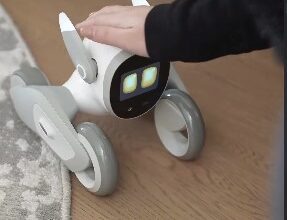
Unleashing the Future: Exploring the Power and Potential of High-Speed Robot Dogs with Swarm Functionality

The new model of robot dogs has brought a remarkable transformation to the field of robotics, revolutionizing the way we perceive and interact with our mechanical companions.
With the ability to develop a speed of up to 17 kilometers per hour and featuring a unique swarm function, these robot dogs have captured the imagination of researchers, engineers, and enthusiasts alike. In this blog post, we will delve into the intricacies of this cutting-edge technology, exploring its potential applications, benefits, and impact on various industries. The concept of robot dogs is not entirely new. Over the years, we have witnessed the development and deployment of various robotic pets and companions, each with its distinctive features and capabilities.
However, the latest advancements in robotics have paved the way for a new breed of robot dogs that push the boundaries of what was previously deemed possible. One of the most notable features of these new robot dogs is their impressive speed. With the ability to reach speeds of up to 17 kilometers per hour, these mechanical canines can navigate their surroundings swiftly and efficiently.
This level of agility and mobility opens up a wide range of applications, from search and rescue operations in hazardous environments to providing support and assistance in emergencies. The swarm function of these robot dogs takes their capabilities to a whole new level. By enabling the synchronization of a pack of robot dogs, this feature allows for coordinated group movements and actions.
Imagine a scenario where a team of these robotic companions works together seamlessly to perform complex tasks or accomplish missions that would otherwise be challenging or even impossible for a single robot dog.
The potential applications range from collaborative exploration of unknown territories to synchronized surveillance and patrol operations. The swarm function relies on advanced communication and coordination algorithms, coupled with sophisticated artificial intelligence systems. Each robot dog within the pack can exchange information, share data, and synchronize actions, creating a cohesive unit that acts as a single entity.

This level of cooperation and coordination reflects the increasingly blurred line between individual robots and collective intelligence, showcasing the potential of swarm robotics in enhancing the capabilities of autonomous systems. The applications of these advanced robot dogs are vast and diverse. In the field of public safety, they can be deployed for search and rescue operations during natural disasters or other emergencies, where their speed and swarm coordination can significantly increase the chances of locating and saving human lives.
Additionally, in security and surveillance scenarios, a synchronized pack of robot dogs can efficiently monitor large areas, detect anomalies, and respond promptly to potential threats.
Furthermore, in industrial settings, these robot dogs can prove invaluable for tasks that require both mobility and coordination. They can be employed in warehouses and logistics centers for efficient inventory management, automated delivery systems, or even as a collaborative workforce alongside human employees. Their flexibility and adaptability make them suitable for a wide range of industries, including manufacturing, agriculture, and construction.
Beyond practical applications, these robot dogs can also serve as companions and therapy aids.
With their lifelike movements and behaviors, they can provide emotional support and companionship to individuals in need, such as the elderly or those with special needs. The synchronized movements of a pack of robot dogs can even be utilized in interactive gaming, entertainment, and art, creating immersive experiences and pushing the boundaries of human-robot interaction. While the advancements in the new model of robot dogs offer a multitude of benefits, it is essential to address potential challenges and ethical considerations associated with their use.
As robots become more integrated into our lives, questions arise regarding issues like privacy, security, and the impact on employment.
Researchers, policymakers, and society as a whole must engage in discussions and establish frameworks that ensure the responsible and ethical deployment of these technologies.






